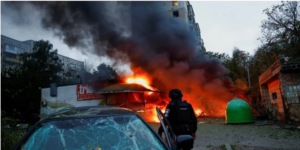
Romania and Moldova have reached an agreement on the construction of a new road bridge across the Prut River, according to a government press release from Bucharest. Under the terms of the memorandum signed by the Romanian government, the project provides for:
– the creation of a new road crossing to strengthen cross-border communication between the two countries and integrate Moldova into the EU transport network (TEN-T).
– the formation of a joint working group and a mixed commission to coordinate technical, financial, and customs issues during the implementation of the project.
– financing from the Romanian budget: in the first phase of the design of four bridges across the Prut, approximately €0.22 billion is to be allocated for each section.
The implementation of the project will help reduce transport time and increase the capacity of roads between Moldova and Romania, as well as improve the overall logistics of the region and speed up transport flows, including between Ukraine, Moldova, and Romania.

Eight earthquakes were recorded in neighboring Romania over four days, according to Romania’s National Institute for Earth Physics Research and Development (INCDFP).
According to the INCDFP, the last three tremors occurred on the night of October 25-26, with an interval of just under an hour. The tremors were recorded in the Vrancea seismic zone, one of the most active earthquake-prone areas in Romania.
The Vrancea seismic zone is located at a depth of about 100 km, so its earthquakes are felt over a large area. In particular, according to a number of reports, the tremors could be felt in Moldova, Bulgaria, Serbia, and southern Ukraine, including the area around the city of Odessa.
The Vrancea zone is known as one of the most dangerous intra-continental seismic areas in Europe, with deep tremors occurring there with magnitudes above 7.0. In such conditions, regional monitoring authorities will intensify their observation and inform the population about the likelihood of repeated events.

On October 22-23, 2025, Kyiv hosted the main event for Ukrainian agri-food business leaders — New Food Summit 2025, which traditionally brings together hundreds of innovators, producers, investors, and experts from across the entire “farm-to-table” chain. This year, the summit became a real platform for demonstrating breakthrough solutions in the field of food technology, where the key topic was the transformation of the agri-food industry through knowledge, innovation, and cooperation.

Education as a driver of progress: AgriAcademy among the summit participants
The educational platform AgriAcademy.org attracted particular attention. It is a free online learning platform created on the initiative of the EBRD as part of its food security support program in Ukraine. Its goal is to strengthen the competitiveness and sustainable development of agriculture, which has suffered significant losses due to the war.
The platform’s creation and management (including course development, training tours, etc.) is supported and funded by the EBRD, as well as:
Representatives of the platform took part in the event, talked to summit participants, presented training opportunities and new courses, and shared their vision of how education is becoming a key component of the development of the Ukrainian agricultural sector.
Videos of leading Ukrainian companies and organizations, including AgriAcademy, were shown on screens in the conference areas, which sparked lively interest among participants. Many specialists in the agricultural and food sectors learned about the platform for the first time, which already offers more than three dozen certified courses in Ukrainian, created in collaboration with universities, companies, and industry associations.
AgriAcademy – the platform of the future of agricultural education
The initiative aims to strengthen the competitiveness of Ukrainian agribusiness and provide access to practical knowledge and modern technologies for farmers, students, teachers, advisors, and managers of agricultural companies. The platform covers topics ranging from production and processing to sustainable development, climate adaptation, precision farming, and innovations in animal husbandry.
“Today, education is the best investment in the sustainability and recovery of the Ukrainian agricultural sector. Our task is to make knowledge accessible to everyone who produces food,” said AgriAcademy representatives during informal discussions at the summit.
Breakthrough products as a result of knowledge and innovation
The New Food Summit culminated in the presentation of the “Breakthrough Product of the Year” awards, which were given to the most innovative Ukrainian developments in the field of “food of the future.” This year, the jury recognized:
These examples show how the combination of technology, entrepreneurship, and education is shaping the new face of Ukrainian food.
The AgriAcademy online platform has already become a space that brings together producers, scientists, experts, and students around a common goal: to create sustainable, innovative, and competitive agricultural production. The platform’s participation in the New Food Summit confirmed its role as a catalyst for knowledge and partnership among all participants in the agri-food ecosystem.
Want to develop your agribusiness and get professional certified education for free?
Register for courses at AgriAcademy.org and learn from the best!

Due to the Russian attack on Kyiv on October 25, the warehouse and office of Ukraine’s second-largest pharmaceutical distributor, Optima-Pharm, were destroyed, according to Ekonomicheskaya Pravda.
According to a source in the pharmaceutical market, the company’s warehouse was “completely destroyed.” It served the central regions of the country. The losses resulting from the attack are close to $100 million.
According to open sources, the Optima-Pharm warehouse covers an area of 29,000 square meters.
Optima-Pharm is the second-largest pharmaceutical distributor after BaDM. The company has been operating in the Ukrainian market for 31 years. The owner of the company is Andriy Hubsky, who does not engage in public activities. According to Forbes Ukraine, his business, with a 33% share and 12 pharmacy warehouses with a total area of 70,000 square meters, remains one of the largest in the pharmaceutical market.

The cryptocurrency market showed signs of cautious recovery between October 20 and 25, 2025, after sharp fluctuations at the beginning of the month. According to CoinDesk, Binance, and CryptoRank, against the backdrop of macroeconomic stabilization, leading crypto assets showed moderate growth but remained highly volatile.
Bitcoin strengthened by about 2-3% over the week, rising above the $110,000 mark again. Experts note that maintaining this level could be a key signal of a recovery in investor confidence. Ethereum also rose 2-3% and consolidated above $4,000, reflecting continued interest in smart contract ecosystems and decentralized applications.
Among altcoins, XRP stood out, gaining about 5% and becoming one of the growth leaders in the top ten of the market. Solana and Binance Coin (BNB) showed minimal changes — from zero to one percent — remaining stable but without noticeable momentum. Cardano rose about 2%, continuing to develop its own ecosystem. Dogecoin gained about 3% amid renewed interest from retail investors.
Chainlink and the HYPE token grew the most during the week, by 10–14% and 30–40%, respectively. Analysts attribute this to increased interest in infrastructure projects and niche solutions that can offer new technologies for interaction in the blockchain environment. Avalanche ended the week with a slight increase of about 2%.
According to experts, the main factor of the week was the gradual return of liquidity to the market. Despite the high outflow of funds from cryptocurrency ETFs, investors began to cautiously build up positions in large assets. Increased expectations of a softening of US Federal Reserve policy and a slowdown in the growth of government bond yields provided additional stimulus for the market.
At the same time, the regulatory environment remains tense: the Financial Stability Board (FSB) reiterated the need to unify the rules for trading cryptocurrencies in different countries. This caused a temporary decline in interest in risky assets, but by the end of the week, the market had partially recovered.
Among the key trends, analysts note the continued dominance of Bitcoin, which accounts for more than 58% of market capitalization. At the same time, a moderate increase in interest in certain altcoins may signal the beginning of a phase of capital rotation and a gradual shift in focus towards technology projects.
Overall, the week ended on a positive note for the market, with the total capitalization of cryptocurrencies remaining close to $3.8 trillion. Experts warn that new correction waves are possible amid continuing uncertainty and weak liquidity, but the fundamentals of market leaders remain stable.
Source: https://www.fixygen.ua/news/20251026/analysis-of-best-cryptocurrencies-from-fixygen.html

When we communicate in English, we often use buffer phrases, many conventions, polite requests, and “soft” constructions, which are perceived as courtesy and friendliness in the English-speaking world. But Ukrainian communication culture is different: here, sincerity, directness, tone, and quality of interaction are more valued than simply formal “politeness” for the sake of politeness. For example, it is said that Ukrainians use the formal “Ви” in formal relationships and refrain from an overly friendly tone, as it may seem insincere. Cultural Atlas+2speakua.com+2
Thus, a phrase that in an English-speaking context means “I am friendly, polite, and ready to cooperate” may sound like “you are not serious,” “I am not in the mood for deep communication,” or even “I am looking down on you” in a Ukrainian context. It is these “cross-cultural pitfalls” that we want to explore today.
Before moving on to specific phrases, here are a few explanations of why this happens:
So, now let’s get down to practice: let’s look at specific English phrases, their literal/typical translation/use, and how they can be understood in Ukrainian (often not as the English speaker expects).
English: “I hope you’re well.”
What the English speaker means: “I hope everything is okay with you.”
How it sounds in Ukrainian: “I hope you are feeling well.”
Why it can be tricky: In the context of a worksheet, it can be interpreted as: “I’m not sure if you’re here,” “I’m not needed here.” In Ukrainian, it is more common to say, “I hope you are well,” which sounds normal, but if it is used as an introductory phrase before a serious request, it may seem distant due to its formality.
How to adapt: “Good afternoon, [Name]” — short, clear, and to the point.
In English: “Would you mind…” (“Would you mind sending the report by Friday?”)
What the English speaker means: to politely ask someone to perform an action.
How it sounds in Ukrainian literally: “Would you mind if…?”
Why it may be perceived as harsh: This construction is rarely used in Ukrainian, and when it is used, it often has the subtext “I don’t really want to, but I have to.” In other words, “Would you mind…?” can be perceived as “I think you might not want to, but we have to.”
How to adapt: Better: “Could you send the report by Friday?” or “Please send the report by Friday.”
In English: “Just to check…” (“Just to check if you received my previous email.”)
What it means: a polite reminder.
How it sounds in Ukrainian: “Just checking if you received…”
Why it’s a trap: “Just checking” can sound like “I doubt you received it” or “I don’t believe you did it.” When communicating with adult Ukrainians, it is better to avoid the word “just” as a minimizer.
Adaptation: “I wanted to know if you received my previous message.” — clearly, without diminutives.
In English: “If possible…” (“If possible, could you join the meeting at 3 pm?”)
What it means: necessity + willingness to accept “no.”
How it sounds in Ukrainian: “If possible, could you join…”
Why it can cause misunderstanding: The Ukrainian “if possible” is often perceived as “most likely impossible, don’t bother.” Instead of “if convenient,” it is better to say “please.”
Adaptation: “We invite you to join the meeting at 3 pm.” If ‘no’ is a real possibility, then: “If it’s convenient for you, please join us at 3 pm.”
In English: “We’ll keep you posted.”
What it means: “We will keep you informed.”
How it sounds in Ukrainian: “We will inform you.”
Why it’s a trap: “We will inform you” often sounds like “you are passive, we decide.” In Ukrainian business interactions, it is better to emphasize commonality: “We will provide you with updates” or “We will inform you about the next steps.”
Adaptation: “We will inform you about the next steps immediately after approval.”
In English: “Like I said before…”
What it means: a reminder of what has already been said.
How it sounds in Ukrainian: “As I said before…”
Why it can sound harsh: In Ukrainian, this phrase can be perceived as “you weren’t listening” or “I’m repeating myself because you forgot.” And that can cause tension.
Adaptation: “As discussed earlier…”
Translating English phrases into Ukrainian literally is like transferring the styles of one culture to another without adaptation. But communication cultures are different: what works in one environment may create distance, misunderstanding, or even offense in another.
● The Ukrainian style of communication is more direct, less subtly “circumventing,” but that does not mean “rude.”
● A large number of conventions or buffer expressions can create the impression that we are speaking insincerely or even formally and coldly.
● In a business or educational context with an adult audience, the following are often valued: clarity, transparency, strength of argument, not “softness.”
● Do not overuse “substitute” phrases. For example: “Just checking in” is fine in an informal letter, but in a formal Ukrainian context it can create an impression of unprofessionalism.
● Check whether the request is perceived as a request and not as a plea for an exception. If you use “If possible,” think about whether it is really possible or whether it sounds like “unfortunately, probably not.”
● Use clear verbs. For example: “Send,” “Discuss,” “Program.” Avoid overly soft constructions if you want action.
● Teach your audience to analyze cultural signals. For example, when an English speaker says “that’s interesting,” it often means “I doubt it.” Similarly, if a Ukrainian interlocutor says “that’s interesting,” it is not necessarily a compliment.
● Encourage directness with respect. In Ukrainian culture, being direct does not mean being rude — it means being clear. Learn to express yourself respectfully but clearly.
Intercultural communication is not just about knowing words or grammar, it is about understanding context, culture, and expectations. When we speak English “politely” and transfer the same model to Ukrainian, we risk not only being “formally polite,” but also creating a sense of distance, uncertainty, or even inappropriate seriousness. But this is not a tragedy — it is an opportunity to learn to adapt. You can learn this in the course “Ukrainian for Foreigners.”